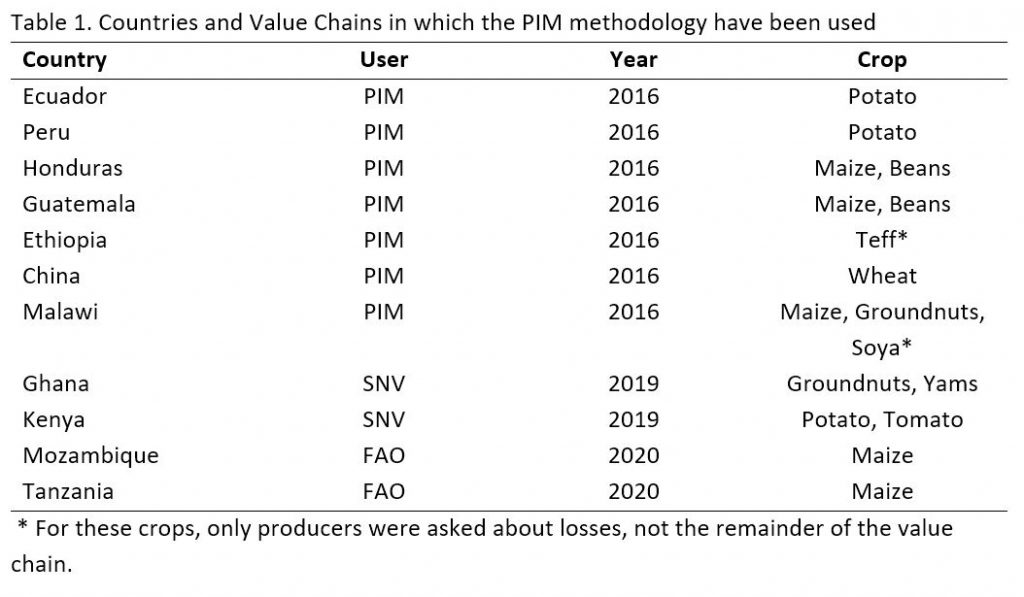The SDG 12.3 target calls to “halve per capita global food waste at the retail and consumer levels and reduce food losses along production and supply chains, including post-harvest losses” by 2030. It is already 2020, and the rapid spread of COVID-19 has raised – along with concerns about general food shortages - the threat of renewed food loss as the world’s food systems are being affected by quickly changing demand patterns.
To create better strategies to reduce food loss and waste, it is important to first measure them accurately and consistently. Measurement, however, is a tricky business. As discussed in the 2019 Report on the State of Food and Agriculture, assessing food loss and waste is not straightforward. It has been done using various methodologies, making it difficult to even compare measurements. Oftentimes, differences in results stem from how the loss is measured rather than from differences in harvest practices, storage, or other factors.
To help make estimates of food loss along the value chain clearer and more consistent over time, researchers supported by the CGIAR Research Program on Policies, Institutions, and Markets (PIM) developed detailed survey modules that can be applied to different components of the food value chain and adjusted to specific commodities. The methodology not only incorporates components of the Food Loss Index for SDG 12.3.1, i.e. on farm post-harvest, transport, storage and distribution, processing and packaging; but it also includes losses identified at the pre-harvest and harvest level, thus capturing the entire value chain up to the consumer.
This methodology allows a quantification of the extent of food loss across the value chain using consistent approaches, comparable across commodities and regions. We can characterize the nature of food loss, specifically the production stages and processes at which the loss happens. Furthermore, it is possible to provide estimates of food losses in different ways: subjective estimates (based on self-reported data); quality attributes lost (inferior visual, tactile, and olfactory product characteristics); and reductions in value, or the price received per unit output (based on the reasoning that price differences of a product in the same locations and in the same time period reflect quality differences.
The methodology was piloted in Ecuador, Peru, Honduras, Guatemala, Ethiopia, China, and Malawi in 2016, followed by Ghana, Kenya, Mozambique, and Tanzania in 2019-2020. For each country and crop combination, the specification of the survey was slightly adjusted to make it more relevant to the context. For example, in Guatemala, the instrument, adjusted for beans, included five quality categories (ranging from 1-2% to over 25% of damaged grain) and thirteen quality attributes (dirty/not clean, chopped, size (small), presence of weevils, acid odor, wrinkled grain, swollen from moisture, rotted by moisture, humid, damage by fungus, different colors, broken grain, other odors).
Across all value chains for which post-farm measures are available, we estimate food losses at between 6 and 28 percent of total production and total produced value. Loss figures are consistently largest at the producer level, which means that much less value is lost within the value chain between producer and consumer. Loss at the producer level tends to represent between 60 and 80 percent of the total value chain loss, while the average loss at the middleman and processor levels lies between 7 and 19 percent. figures are larger than those recently obtained by Kaminski and Christiansen (2014) and Minten et al. (2016a and b) due to the inclusion of qualitative loss, but generally much smaller than the oft-cited statistic that one-third of food is lost or wasted.
These results suggest that interventions to reduce food loss should concentrate on the farm link of the value chain, or close to it. It is important to target smallholders with techniques that help them grow food with more marketable attributes (to reduce value loss) and improve on- or near-farm storage capabilities. As Brenda Mareri, SNV, noted, “Understanding the extent of food losses at each stage of the value chain, and its causes, helps SNV and the civil society groups we work with better target our advocacy for solutions.”
In the time of crisis such as the world is living through now, it is critical to use available resources as efficiently as possible. Consistently measuring post-harvest loss can help prioritize the right types of interventions to make sure that more nutritious food gets to consumers who need it.
Related publication:
Delgado, Luciana; Schuster, Monica; and Torero, Maximo. 2017. The reality of food losses: A new measurement methodology. IFPRI Discussion Paper 1686. Washington, D.C.: International Food Policy Research Institute (IFPRI). https://ebrary.ifpri.org/cdm/ref/collection/p15738coll2/id/131530
Luciana Delgado is research analyst and Alan De Brauw is senior research fellow at the Markets, Trade, and Institutions division of IFPRI. Alan De Brauw co-leads PIM's cluster of research on Interventions to Strengthen Value Chains and leads the cluster on Value Chains Research: Outreach and Scaling within Flagship 3: Inclusive and Efficient Value Chains.
Photo by Devrig Velly EU/ECHO




